Used with high contrast subjects, High Dynamic Range (HDR) preserves details in highlights and shadows by combining two shots taken at different exposures. HDR is most effective when used with matrix metering (with spot or center-weighted metering, an exposure differential of Auto is equivalent to about 2 EV). It cannot be combined with some camera features, including NEF (RAW) recording, flash photography, bracketing, multiple exposure, shutter speeds of Bulb and Time, or interval timer, focus shift, or time-lapse recording.
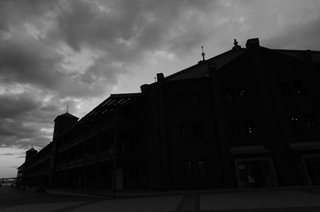
First exposure (darker)
+
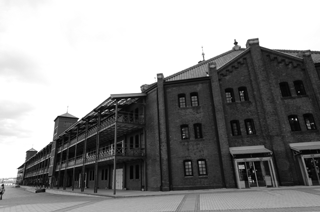
Second exposure (brighter)


Combined HDR image
The following options are available:
- HDR mode: Choose from On (series) (take a series of HDR photographs, ending when Off is selected), On (single photo) (take one HDR photograph), and Off (exit without taking additional HDR photographs).
- Exposure differential: Choose the difference in exposure between the two shots that are combined to make an HDR photograph. Choose larger values for high-contrast subjects, or select Auto to let the camera adjust the exposure differential according to the scene.
- Smoothing: Choose how much to smooth the boundaries between the shots that make up each HDR photograph.
- Save individual images (NEF): Choose On to save each of the individual shots used to create the HDR image. The photos are saved as large-size NEF (RAW) files regardless of the options selected for image quality and size in the photo shooting menu.
Taking HDR Photographs
Follow the steps below to shoot HDR photographs.
-
Select HDR (high dynamic range).
Highlight HDR (high dynamic range) in the photo shooting menu and press 2.
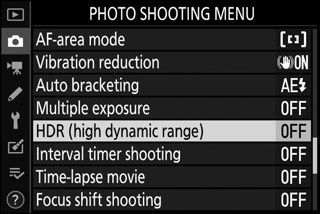
-
Select a mode.
Highlight HDR mode and press 2.
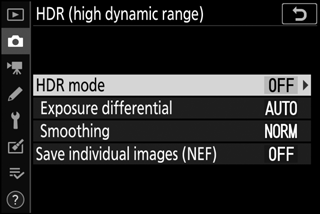
Highlight one of the following and press J.
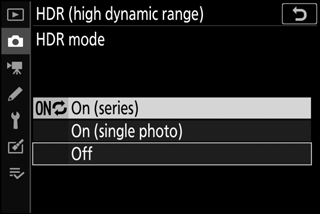
- To take a series of HDR photographs, select 0 On (series). HDR shooting will continue until you select Off for HDR mode.
- To take one HDR photograph, select On (single photo). Normal shooting will resume automatically after you have created a single HDR photograph.
- To exit without creating additional HDR photographs, select Off.
If On (series) or On (single photo) is selected, an icon will appear in the display.
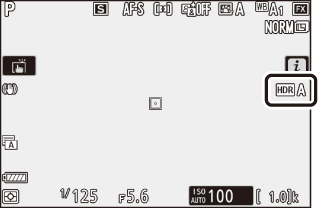
-
Choose the exposure differential.
To choose the difference in exposure between the two shots, highlight Exposure differential and press 2.
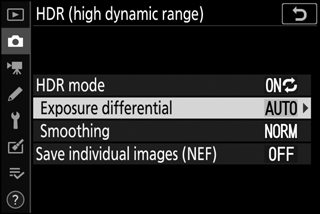
Highlight an option and press J. Choose higher values for high-contrast subjects, but note that choosing a value higher than required may not produce the desired results; if Auto is selected, the camera will automatically adjust exposure to suit the scene.
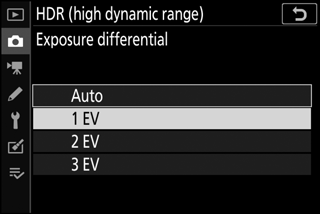
-
Choose the amount of smoothing.
To choose how much the boundaries between the two images are smoothed, highlight Smoothing and press 2.
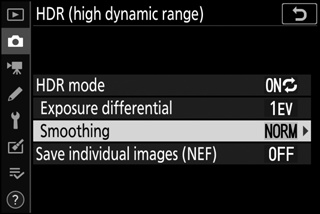
Highlight an option and press J. Higher values produce a smoother composite image. Uneven shading may be visible with some subjects.
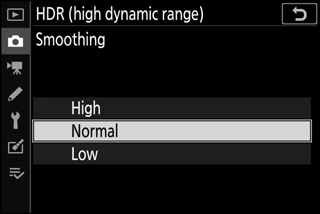
-
Choose whether to keep individual exposures.
To choose whether to save the individual NEF (RAW) images that make up the HDR photograph, highlight Save individual images (NEF) and press 2, then press 1 or 3 to choose the desired option and press J to select.
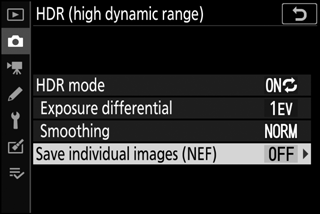
-
Frame a photograph, focus, and shoot.
The camera takes two exposures when the shutter-release button is pressed all the way down. “Job” and “HDR” will flash in the control panel while the images are combined; no photographs can be taken until recording is complete. Regardless of the option currently selected for release mode, only one photograph will be taken each time the shutter-release button is pressed.

If On (series) is selected, HDR will only turn off when Off is selected for HDR mode; if On (single photo) is selected, HDR turns off automatically after the photograph is taken.
Framing HDR Photographs
The edges of the image will be cropped out. The desired results may not be achieved if the camera or subject moves during shooting. Use of a tripod is recommended. Depending on the scene, shadows may appear around bright objects or halos may appear around dark objects; this effect can be reduced by adjusting the amount of smoothing.
